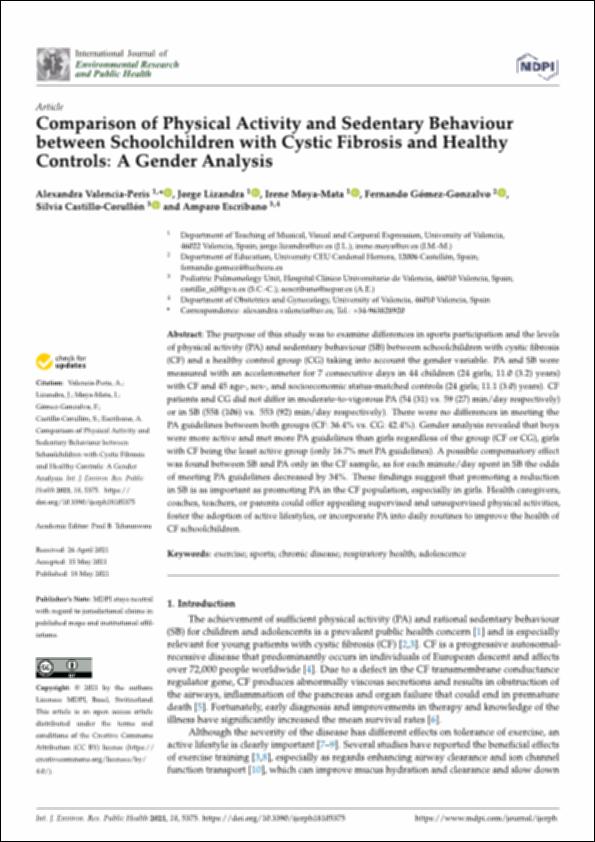Por favor, use este identificador para citar o enlazar este ítem:
http://hdl.handle.net/10637/13658Comparison of physical activity and sedentary behaviour between schoolchildren with cystic fibrosis and healthy controls : a gender analysis
| Título : | Comparison of physical activity and sedentary behaviour between schoolchildren with cystic fibrosis and healthy controls : a gender analysis |
| Autor : | Valencia Peris, Alexandra Lizandra Mora, Jorge Moya Mata, Irene Gómez Gonzalvo, Fernando Castillo Corullón, Silvia Escribano, Amparo |
| Materias: | Fibrosis quística - Pacientes.; Deportes - Aspectos fisiológicos.; Sports - Physiological aspects.; Respiratory organs - Diseases.; Students - Exercise.; Cystic fibrosis - Patients.; Aparato respiratorio - Enfermedades.; Estudiantes - Ejercicio físico. |
| Editorial : | MDPI |
| Citación : | Valencia-Peris, A., Lizandra, J., Moya-Mata, I., Gómez-Gonzalvo, F., Castillo-Corullón, S. & Escribano, A. (2021). Comparison of physical activity and sedentary behaviour between schoolchildren with cystic fibrosis and healthy controls: a gender analysis. International Journal of Environmental Research and Public Health, vol. 18, i. 10 (18 may.), art. 5375. DOI: https://doi.org/10.3390/ijerph18105375 |
| Resumen : | The purpose of this study was to examine differences in sports participation and the levels of physical activity (PA) and sedentary behaviour (SB) between schoolchildren with cystic fibrosis (CF) and a healthy control group (CG) taking into account the gender variable. PA and SB were measured with an accelerometer for 7 consecutive days in 44 children (24 girls; 11.0 (3.2) years) with CF and 45 age-, sex-, and socioeconomic status-matched controls (24 girls; 11.1 (3.0) years). CF patients and CG did not differ in moderate-to-vigorous PA (54 (31) vs. 59 (27) min/day respectively) or in SB (558 (106) vs. 553 (92) min/day respectively). There were no differences in meeting the PA guidelines between both groups (CF: 36.4% vs. CG: 42.4%). Gender analysis revealed that boys were more active and met more PA guidelines than girls regardless of the group (CF or CG), girls with CF being the least active group (only 16.7% met PA guidelines). A possible compensatory effect was found between SB and PA only in the CF sample, as for each minute/day spent in SB the odds of meeting PA guidelines decreased by 34%. These findings suggest that promoting a reduction in SB is as important as promoting PA in the CF population, especially in girls. Health caregivers, coaches, teachers, or parents could offer appealing supervised and unsupervised physical activities, foster the adoption of active lifestyles, or incorporate PA into daily routines to improve the health of CF schoolchildren. |
| Descripción : | Este artículo se encuentra disponible en la siguiente URL: https://www.mdpi.com/1660-4601/18/10/5375 Este artículo pertenece al número especial "Physical Activity and Socioenvironmental Factors in Students". |
| URI : | http://hdl.handle.net/10637/13658 |
| Derechos: | http://creativecommons.org/licenses/by/4.0/deed.es |
| ISSN : | 1660-4601 (Electrónico) |
| Fecha de publicación : | 18-may-2021 |
| Centro : | Universidad Cardenal Herrera-CEU |
| Aparece en las colecciones: | Dpto. Ciencias de la Educación |
Los ítems de DSpace están protegidos por copyright, con todos los derechos reservados, a menos que se indique lo contrario.


